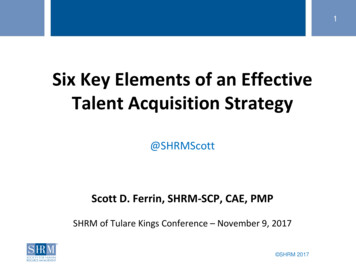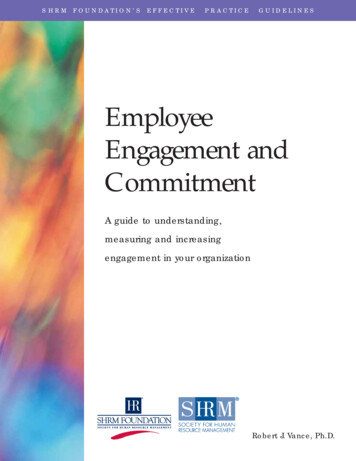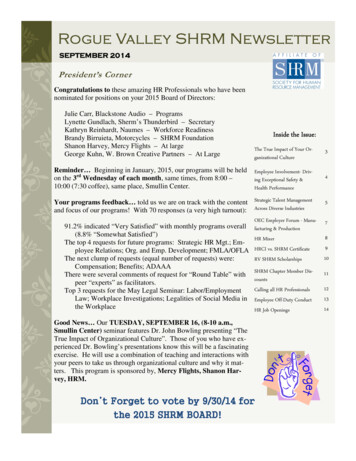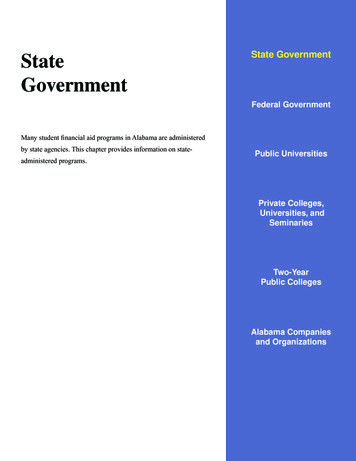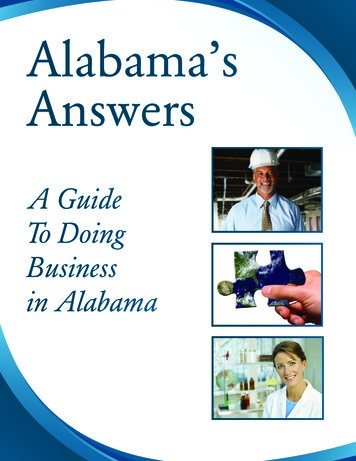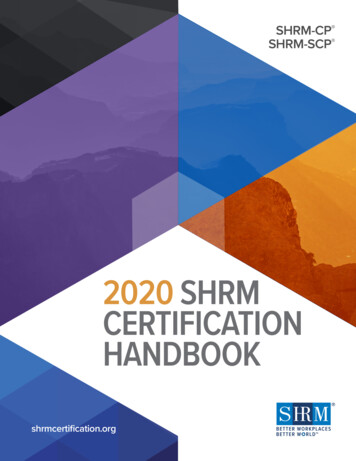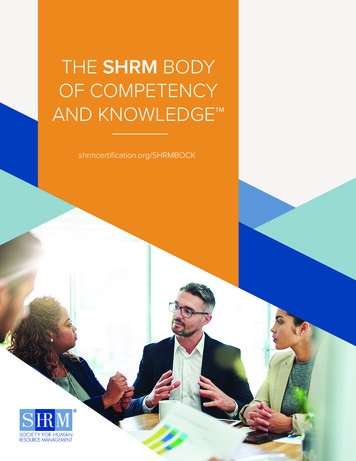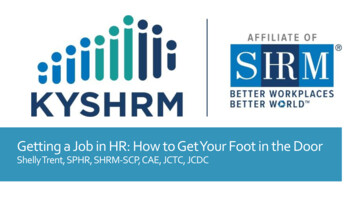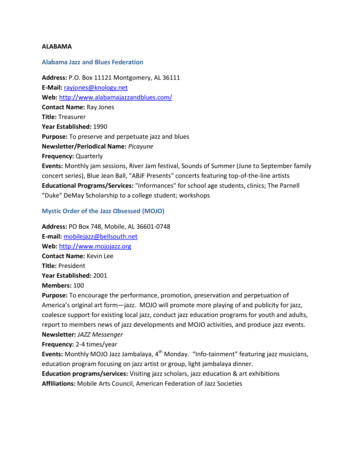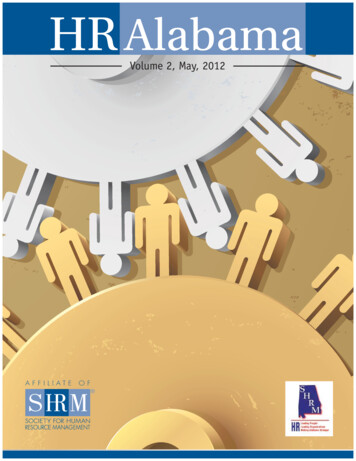
Transcription
AlabamaVolume 2, May, 2012AFFILIATEOF
Which direction are Pointing your employee benefits program in thesame direction as your company’s future can bea challenging task for an HR Manager.Alliance Insurance Group is a consulting firm specializing solely onemployee benefits. Founded with the idea that small and mid-sizecompanies need innovative solutions driven by soundstrategy and client service, we show our clients how tosynchronize their HR goals with corporate goals. Proudly serving theSoutheast! Alabama1
AlabamaVolume 2, May, 2012About HR AlabamaVolume 2, May, 2012HR Alabama magazine is published annually by the SHRM Alabama State Council, anaffiliate of the Society for Human Resource Management. The publication is a volunteer effort that endeavors to provide HR professionals in Alabama with useful, thought-provokinginformation and ideas. HR Alabama is distributed free of charge to SHRM-Affiliate chaptermembers and non-chapter affiliated SHRM members throughout Alabama.HR Alabama and the SHRM Alabama State Council would like to thank the many fineprofessionals that contributed their time to contribute articles, the advertisers without whomHR Alabama would not be possible, and our partner the Anniston Star, a unit of Consolidated Publishing Company. Special thanks to Anniston Star staffers Demetrius Hardy, whohandled advertising and Patrick Stokesberry, who did the graphics and layout.All positions and opinions expressed in the articles are those of the authors, and do notrepresent the views of the SHRM Alabama State Council or SHRM. Please feel free to sendyour feedback or comments (positive, or not-so-positive!) to any of the contributors, or tothe Editor.If you are interested in contributing to the 2013 edition of HR Alabama, contact JohnFaure. For advertising information, please contact Paula Watkins.HR Alabama is available for download in PDF format athttp://www.shrmalabama.org.We hope you enjoy the magazine!Respectfully,Paula Watkins, SPHRAdvertising Sales and Circulationpwatkins@lyonshr.comJohn Faure, SPHREditorFaure@Bellsouth.net2AlabamaAFFILIATEOF
Employment lawcan change your business. ! % & !# " !) % ( % ( ) & % ! ! & " ! ! # &# %%!# ) "#!' % & " %! ! ' % %!& % & & ( !&# ( # % ! % % ! !# !# * ! " "#! # %# !% # % ! % ( % & % " !) % ( % )!&# & )! & # !&# ! % % ! # %! ) ; 7 7# 7# )) 7)#7)# % #) #) # ) # ) : # ; # %!# 8# ! , #) ! #) ! .4.5 2% ' & % .-7 # 9 02/-0/-2 /11 2/-- @ (! 6?! ( # !7# ) 7)# /21 % % % :! 9 033-0/2. 10/ .1.1 @ )# 6?! ( # !Honoring the past. Embracing the future. ALABAMA ARIZONA DISTRICT OF COLUMBIA FLORIDA LOUISIANA MISSISSIPPI TEXAS Alabama3
SHRM ALABAMA STATE COUNCILThe SHRM Alabama State Council is an affiliate of SHRM (Society for Human ResourceManagement) the world’s largest human resource management association in the world. The StateCouncil is comprised of the presidents of the professional chapters, core leadership area (CLA)directors, and district directors. Our mission is to be the resource for all workplace issues in Alabamaand to support the affiliated chapters in the state while also supporting the goals of SHRM. Alabamahas fifteen affiliated professional chapters: Baldwin County SHRM (Daphne) Birmingham SHRM Calhoun County SHRM (Anniston) Cullman Area - SHRM East Alabama SHRM (Auburn/Opelika) Escambia County SHRM Marshall County HR Management Association Mobile SHRM North Alabama Chapter of SHRM (Huntsville) Northwest Alabama SHRM (Winfield) SHRM - Montgomery Shoals Chapter- SHRM (Florence) Tennessee Valley Chapter of SHRM (Decatur) Tuscaloosa HR Professionals Wiregrass HR Management Association (Dothan)The Alabama SHRM State Conference is currently the State Council’s only revenue generatingproject. The proceeds from the conference are used to financially assist the chapters with HumanResource Certification Institute (HRCI) training, bi-annual Hill visits to Washington DC to talk withthe Alabama delegation about issues that impact HR and travel expenses to attend SHRM LeadershipConferences.Last year was the maiden voyage of the HR Alabama magazine and this year it has grown tremendously.I want to thank all the sponsors and advertisers for making this magazine possible; without them wewould not be able to produce such quality work. The Anniston Star has done a remarkable job as well.Paula Watkins, John Faure and all the sales team are to be commended for all their hard work. Paulaand John’s leadership is what made this magazine possible.Pam Werstler, SPHRAlabama SHRM State Council Director4Alabama
! .*ƫ 3ƫ5 1ƫ *ƫ ""!.ƫ ý ƫ0 ƫ5 1.ƫ!),( 5!!/ƫ 0ƫ* ƫ /0ƫ0 ƫ5 1.ƫ 1/%*!//ċƫƫ *0 0čƫƫ .% *ƫ **ƫƫĂĆćċĈąĊċĈăćăƫƫ.% *Ĥ) **Į1/ċ ý ċ )ƫ ' & () ) ' # * ' % " !! Alabama5
AlabamaTable Of Contents10 Gender Wage Gap: The Rest of the StoryBy Charles Wilkinson, SPHR & Carolyn Campbell16 Watch Out! Aggression in the WorkplaceBy Jack Howard20 What Makes a Good Manager? And How Do I Hire One?By Fred Rogan24 Be Nice And Play Fair. Non-Legal Advice From Two AttorneysBy R. Bradley Adams and Kelly D. Reese28 Moxie in Motion: HR as Catalyst for Strategy ExecutionBy Doug Dean, CCP, SPHR36 Leading the People Who Are LeftBy Michael Alan Tate, CMF44 Investigating & Responding to EEOC ChargesBy Tammy Baker48 Twenty-One Reasons Why Obvious People Problems Don’t Get AddressedBy John Faure, SPHR52 Self-Sabotage: The Top 7 Employer MistakesBy Katherine E. Reeves56 Who’s Responsible For Training Your Employees on Social Media Ethics?By Andrea Walker58 How to Unionize Your WorkforceBy Richard Lehr & David Middlebrooks64 HR: The Next GenerationBy Paula Watkins , SPHR666AlabamaThe Secrets of Getting The Most From Your Recruitment AdvertisingBy John Faure, SPHR & Dawn Hrdlica Burke, PHR
Senator Richard Shelby (R., AL) with Alabama SHRM Members in March, 2012 SHRM Alabama members with Rep. Mo Brooks (R., AL) in March, 2011Alabama7
Alabama SHRM State Council on the Capitol steps March, 2009 SHRM Alabama members in front of the Rayburn House Office Building, September, 20108Alabama
SHRM Alabama members on the Fall, 2010 Hill Visit Alabama SHRM members in a House Office tunnelAlabama9
Gender Wage Gap:The Rest of the StoryBy Charles Wilkinson, SPHR and Carolyn CampbellMost HR professionals are probably like us in the sense that when we hear governmentofficials or members of the news media cite the statistic that women make 81 centsfor every dollar that men make we become very uncomfortable and want to know moreabout why. It’s almost hard to believe that this could even be true in 2012. Since mostof these “drive by” remarks in the media rarely include any substance to back it up, weset about reviewing some of the most recent research to answer the burning question ofwhy. Like us, you may be surprised by what we learned.INTRODUCTIONWomen have made significant progress in the past threedecades in a number of important ways. Younger women arenow more likely than younger men to have a college degree,and more women than men have received graduate degrees.An increasing percentage of women are working (and in higher-paying occupational categories traditionally dominated bymen) and the number of women in the labor force has nearlyequalized that of men in recent years. These gains in educationand labor force involvement have not, however, fully translated into wage and income equity for women. But why?BY THE NUMBERSThe gender wage gap, which by definition is the differencebetween wages paid to women and men, has been a source ofboth political debate and economic research for at least thepast three decades. The wage gap is most commonly calculatedas the ratio of the median earnings of women and the medianearnings of men, which indicates the percentage of male earnings that the female earnings represent. When the ratio is calculated for all full-time men and women who are paid wages,the measure is often called the “raw” gender wage gap.According to the Bureau of Labor Statistics (BLS) 2010Highlights of Women’s Earnings Report (July 2011), womenwho were full-time wage and salary workers earned 81 percentof the median weekly earnings of their male counterparts in2010. For many people hearing this statistic, the first and mostnatural reaction is that gender discrimination must be thereason. While this may certainly be the case, the statistic alonetells us nothing at all about discrimination.10AlabamaMORE TO THE STORYThe inherent flaw in the raw gender wage gap calculation isthat such comparisons of earnings are on a very broad leveland do not take into consideration many relevant factors thatcan be significant in explaining earnings differences. The statistic does not take into account what most employers commonlyconsider to be “compensable factors,” such as differences inexperience, skill, etc. It does not, for example, compare thewages of female doctors or lawyers to male doctors or lawyers;it compares all working women in an industry or occupationwith all working men. Not surprisingly then, there is going tobe a gap. This greatly limits the usefulness and meaningfulnessof the statistic to fully understand compensation differences.The other problem is that all too often the gap statistic isquoted with the same fervent belief of a Bible verse, butwithout the necessary discussion to explain the underlyingreasons for the gap. As a result, the raw wage gap is frequentlyinterpreted and used by some as clear evidence of overt wagediscrimination against women, and as political justification forlegislation and administrative policies governing pay equality.To highlight this concern, in 2009, the U.S. Department ofLabor released a report entitled, “An Analysis of the Reasonsfor the Disparity in Wages between Men and Women.” In theForeword written by Charles E. James, Sr., Deputy AssistantSecretary of the Office of Contract Compliance, he stated that,“ the raw wage gap continues to be used in misleading waysto advance public policy agendas without fully explaining thereasons behind the gap.”AND NOW, THE REST OF THE STORYAccording to researchers Blau and Kahn, there are several
ANNUAL GULF COAS TH UMAN R ESOURCE CONFE R E NCEM O B I L E C O N V E N T I O N C E N T E R M O B I L E , ALN O V E M B E R 9 , 20 12Welcome Reception:Thursday, November 8, 2012from 6:00 pm - 8:00 pmHampton Inn & Suites Downtown Mobile, ALMeagan JohnsonKeynote Speaker,Opening – General SessionTopic: Zap the GapConference:Friday, November 9, 2012from 7:30 am - 4:00 pmMobile Convention Center Downtown Mobile, ALTom & Kelly Woodford,The Kullman FirmGeneral Session - Legal UpdateBook signing followingat America’s First Federal CreditUnion Exhibitor BoothSalome Barrientos,Robert Holmes,HHS InvestigationsRetired Alabama PowerConcurrent Session - eVerify & I-9 AuditsConcurrent Session - Ethics and HRGreg Dillion,Mary White,Jeremy York,Georgia Institute of TechnologyMTI Business SolutionsDirector of HR - Novia CareClinicsConcurrent Session - Strengthening the LinkBetween HR, Safety and Risk ManagementConcurrent Session - Leadership Essentials:What Separates Leaders from ManagersConcurrent Session - Performance ManagementHRCI CREDIT APPROVAL PENDING 99 - Early Bird Registration begins July 1, 2012Visit www.mobileshrm.org for more information or email conference@mobileshrm.orgAlabama11
primary factors that individually and collectively explain mostif not all of the observed difference between wages paid towomen and wages paid to men. In fact, research shows that thefollowing factors may explain as much as 72.3% of the wagegap (or nearly 14 of the 19 cent gap): occupational choice,industry sector, education, work experience, race and unionstatus. In addition, various research indicates that the 27%unexplained portion of the gap can be attributed to individualchoices that impact earnings, including motherhood, careerinterruption, compensation expectations, willingness to negotiate, hours worked (including overtime) and cash paid as atradeoff for lack of benefits. Figure 1 illustrates the estimatedpercentage of the raw wage gap explained by each factor.For example: According to the Bureau of Labor Statistics, thecategory of legal occupations has the largest raw wage gap,with a difference of 43.4%. Within this classification, there arefour (4) sub-sets of jobs: (1) lawyers, (2) judges, magistratesand other judicial workers, (3) legal assistants and paralegals,and (4) miscellaneous legal support workers. Men are disproportionately concentrated in the “lawyer” title (77.2%)while women are disproportionately concentrated in the “legalassistants and paralegals” title (86.7%). Obviously, lawyers aretypically much higher paid than either legal assistants or paralegals, and for that reason incumbents in these positions wouldnever be compared to each other by employers during a typicalcompensation evaluation.Figure 1: Factors Explaining the Raw Gender Wage GapFigure 2: Concentrations of Men and Women in LegalOccupationsInformation Source: Blau and Kahn, “The Gender Pay Gap,” Economists’ Voices (June 2007)Role of Occupational ChoicesHistorically, men and women have made different occupational and career choices. As a result, the percentage offemale workers often varies significantly among occupations.Researchers have independently and consistently concludedthat the main factor accounting for the gender wage gap isdifferences between the occupations in which men and womentypically work. This factor alone is credited for explaining 27.4percent of the raw gender wage gap.Whether by choice or limited opportunity, women have beendisproportionately represented in occupational classificationswith relatively lower wages (e.g., education, service, sales, clerical) and men have been disproportionately represented in occupational classifications with comparatively higher wages (e.g.,construction, financial, engineering, scientific). As a result, theaverage and median earnings of women in general have beenmuch lower than the average and median earnings of men ingeneral.In each of the twenty-two (22) occupational categories trackedby the Bureau of Labor Statistics, women are reported as earning less than male counterparts. This can be partially explainedby examining the various job titles within each occupation.Doing so further reveals the inherent flaw in this statistic.12AlabamaInformation Source: Bureau of Labor Statistics, 2010 Highlights ofWomen’s Earnings Report (July 2011)This illustration explains why large differences in compensation between women and men can still exist even after controlling for occupational categories, or any other legitimatecontributing factor for that matter.Of course, the wage gap statistic tells us nothing at all aboutthe underlying reasons for the concentration of men or womenin certain occupations, and should not be used to do so. Whilesome may argue that the occupational choices of women arelimited or “pre-determined” because of stereotype or discrimination, this would seem to discredit the achievements ofwomen who are currently succeeding in positions historicallydominated by men, and women who choose to work in positions historically dominated by women.Role of Personal ChoicesAccording to the U.S. Department of Labor report entitled,“An Analysis of the Reasons for the Disparity in Wages betweenMen and Women” (2009), research has shown that after controlling for the most predictive factors for the wage gap (suchas occupational choices, industry category, work experience,education, race and union status) there remains an adjusted
37 1 33 3 3 7 33 3 7 7 ) 8 1 7 7 3 7 7 1 . & 1 & ' (6 * . 7 ( 7 ( 2 . & 2 1 & . (6 ) . / ' , ) 0 / 2 & . " # ! " % % " " % 7 2 (6 * . - , 3 7 3 3 8 6 7 3 3 2 7 / 7 4 7 5 7 7 6 - , (6 * . # 7 3 97 ) 3 " ! Alabama13
gender wage gap that is between 4.8 and 7.1 percent.trade higher pay for other desirable job characteristics.The report states that there are factors and observable differences in the attributes of men and women that accounts formost of this remaining wage gap. These include: A greater percentage of women than men tend to leave thelabor force for child birth, child care and elder care. Some ofthe wage gap is explained by the percentage of women whowere not in the labor force during the previous years. Whilesome may argue that this represents discrimination at the societal level and reflects poorly on the cultural norms regardingthe role of women, it does not reasonably suggest compensation discrimination that an employer should be held liablefor. Thomas Sowell argued in his 1984 book Civil Rights thatmost of pay gap is based on marital status, not “glass ceiling”discrimination, and that earnings for men and women ofthe same basic description (education, jobs, hours worked,marital status) were essentially equal. That result would not bepredicted under explanatory theories of “sexism”. However, itcan be seen as a symptom of the unequal contributions madeby each partner to raising children and providing other familycare. A greater percentage of women than men tend to work parttime. Part-time work tends to pay less than full-time work.In fact, women are nearly twice as likely as men to work parttime. In 2009, 66.6 percent (about two-thirds) of Americanworkers working fewer than 35 hours in the typical workweekwere women. By comparison, just 45.1 percent of workerslogging more than 35 hours a week were women. In 2010,26.6 percent of women worked part time compared to just13.4 percent of men. Men are more likely to work longer hours than women.The average full-time working man works 6 hours per weekor 15% longer than the average full-time working women. Itlogically follows that if men are working longer hours they arelikely being paid more overtime hours, and their earnings willbe higher than those of women. Men are much more likely to work in jobs that involvemore demanding physical labor and extreme conditions suchas outdoor work, overnight shifts and dangerous conditions.This would seem to explain why men are involved in theoverwhelming majority of injuries and deaths at the workplace. Men have been more profoundly impacted by the currentrecession because they tend to work in fields like construction,manufacturing and transportation, which are disproportionately affected by bad economic conditions. Women are represented in more insulated occupations, such as teaching, healthcare and service industries. If it is reasonable to accept that thejob choices of men and women lead to different unemployment rates, then it may also stand to reason that it leads toother differences—like differences in average pay. Women, especially working mothers, tend to value “family friendly” workplace policies more than men. Some of thewage gap is explained by industry and occupation, particularly, the percentage of women who work in the industryand occupation. While it has been suggested that women areconcentrated in lower-paying occupational categories becauseof limited access to opportunities, others would suggest thatwomen gravitate toward jobs with fewer risks, more comfortable conditions, regular hours, more personal fulfillment andgreater flexibility. Simply put, many women—not all, butenough to have a big impact on the statistics—are willing to14Alabama Differences not incorporated in current research modelsdue to data limitations may account for the remaining partof the gap. Specifically, the Bureau of Labor Statistics annualHighlights of Women’s Earnings Report focuses exclusivelyon wages rather than total compensation. Research indicatesthat some women may value non-wage benefits more thanmen do, and as a result prefer to take a greater portion oftheir compensation in the form of health insurance and otherfringe benefits. Benefits typically account for between 20%and 30% of total compensation, but the influence of this factor on the gender pay gap has been largely ignored by studies.CONCLUSIONIn the Foreword of the U.S. Department of Labor report entitled, “An Analysis of the Reasons for the Disparity in Wagesbetween Men and Women” (2009), Deputy Assistant Director of the Office of Federal Contract Compliance Programs,Charles E. James, Sr., stated that, “ this study leads to theunambiguous conclusion that the differences in the compensation of men and women are the result of a multitude of factors and that the raw wage gap should not be used as the basisto justify corrective action. Indeed, there may be nothing tocorrect. The differences in raw wages may be almost entirelythe result of the individual choices being made by both maleand female workers.”Volumes of economic research have identified numerous factors that contribute to the gender wage gap. Many of thesefactors relate to differences in the choices and behavior ofwomen and men in balancing their work, personal, and family lives.
opportunity for all. But, using the gender wage gap statistic tosummarily conclude that any and all pay differences by gender isthe result of discrimination without examining the other potential reasons may well prove to be a hasty generalization.Since 1979 when the Bureau of Labor Statistics first startedtracking it, the size of the raw gender wage gap has significantlynarrowed. Median earnings for women as a percentage of medianearnings for men have steadily increased from 62.5 percent in1979 to 81 percent in 2010. This is largely attributed to the factthat women have been making different occupational choices andare being provided access to more and higher-paying opportunities than in previous decades.Sources:Blau and Kahn, “The Gender Pay Gap,” Economists’ Voices(June 2007)Bureau of Labor Statistics, 2010 Highlights of Women’s EarningsReport (July 2011)Bureau of Labor Statistics (BLS), 2010 Highlights of Women’sEarnings Report (July 2011)Thomas Sowell, Civil Rights: Rhetoric or Reality (1984)CONSAD Research Corporation, U.S. Department of Labor,“An Analysis of the Reasons for the Disparity in Wages between Menand Women” (2009)White House Council on Women and Girls, “Women in AmericaIndicators of Social and Economic Well-Being” (March 2011)The one thing that all research on the subject seems to demonstrate is this: that it is not possible now, and will doubtless everbe possible, to determine with absolute certainty what portion (ifany) of the gender wage gap is attributable to factors that compensate women and men differently due to overt discriminationagainst women.Even if 100% of the gender wage gap cannot be fully explainedby the impact of legitimate factors related to the personal choicesof men and women that current research would have us believe, itseems unreasonable to conclude that the entire gender wage gapis attributable to gender discrimination.CHARLES WILKINSON, SPHR (charles@hrmasap.com)is CEO of Human Resource Management, Inc., a humanresource consultancy based in Birmingham, Alabama.Unfortunately but most certainly, compensation discrimination does exist in our country. Landmark cases like that of LillyLedbetter are regular reminders that while much progress hasbeen made, much work yet remains to ensure equal employment CAROLYN CAMPBELL (carolyn@hrmasap.com)is Chief Development Officer for Human ResourceManagement, Inc. & # ! "# ' & #" " # "CONTROL COSTSENSURE COMPLIANCECUSTOMIZE PROGRAMS / SOLUTIONSREDUCE ADMINISTRATIVE WORKLOAD / - /, , ) % ,( ,* ( ( ( 0 * ( *,1 , *, * ) ( ) , , ,. ) ) *, ( , ., ( ( , ( / , , / 0, , /UR PRIORITY IS TO ENSURE THAT YOU AND YOUR EMPLOYEES RECEIVE THE h"EST IN #LASSv .,( , # / * 0 *, ) ( , , (,1 ) , HUB International/// , , ( ,- ( ! ! ! "MIKE LONCONO HUBINTERNATIONAL COM s At your service in all 50 United States and the provinces and territories of Canada.Alabama15
Watch Out!Aggression in the WorkplaceBy Jack L. HowardDuring a departmental meeting at the University of Alabama-Huntsville, afaculty member opens fire on her colleagues. An employee enters the workplace and begins shooting coworkers. While many coworkers escape, somedie. An Army doctor opens fire killing 13 in his rampage. At the MontgomeryPost Office a former employee fires two shots in 2011. Fortunately no onewas hurt in that particular incident. On December 14, 2011 a supervisor wasstabbed to death at a grocery store in the greater Birmingham area.16Alabama
These are the types of incidents that capture the media’sattention with three of the incidents occurring in Alabama.As a result, some people envision these high profile events asthe primary type of aggression in the workplace. Estimatesmade by NIOSH indicate that workplace violence, the mostextreme and least frequent form of workplace aggression,cost businesses 6.5 billion from 1992 through 2001 justaddressing the homicides. This does not include any otherinjuries, turnover or reduced productivity associated withthese extreme situations.While no hard statistics exist regarding the costs ofaggression and bullying, research has demonstrated thatthey occur more frequently than violence. Furthermore,if someone is distracted by these types of issues, they arenot producing at 100 percent. Consequently it is important to recognize that there are costs associated with thesemore frequent but less severe behaviors in the workplace.The purpose of this article is to raise the awareness of HRprofessionals in Alabama of the various types of aggression,the potential perpetrators, and the steps that can be taken toprovide a safe workplace.AGGRESSIVE BEHAVIORSAggressive behaviors take a variety of shapes. While therecan be many different definitions, a framework to betterunderstand aggression in the workplace breaks it down intothree primary categories. The lowest level consists of expressions of hostility. Examples of this level consist of employeesmaking negative comments towards one another, the use ofgestures towards one another or yelling at each other. Thesecond level is obstructionism and includes actions by anemployee towards another employee to limit the ability ofthe employee to complete his or her job. An example of thisbehavior can be withholding information that an employeeneeds to perform his or her job. Finally, the third level ofbehavior is overt aggression and often times involve aggressive behaviors that are physical in nature, often timesreferred to as violence.A related concept is workplace bullying. Bullying differsfrom aggression in that aggression can occur once. It canalso occur multiple times. Workplace bullying, however,is repeated and is often aimed at adversely affecting one’sability to perform at work. Whether this is hazing of newemployees, such as a passage of rites in some occupations orfields, or this is another employee picking on or singling outanother employee, it occurs on a repeated basis over time.In terms of the three level framework, overt aggression, while covered in the press, is the least likely to occur.That does not mean that it should be ignored. Rather, it isimportant to understand that obstructionism, expressionsof hostility and bullying are more likely to occur. Whetheryou want to call this a lack of professionalism or incivilityin the workplace, it occurs more often than the violenceassociated
HR Alabama magazine is published annually by the SHRM Alabama State Council, an affiliate of the Society for Human Resource Management. The publication is a volunteer ef-fort that endeavors to provide HR professionals in Alabama with useful, thought-provoking information and ideas. HR Alabama is distributed free of charge to SHRM-Affiliate .
